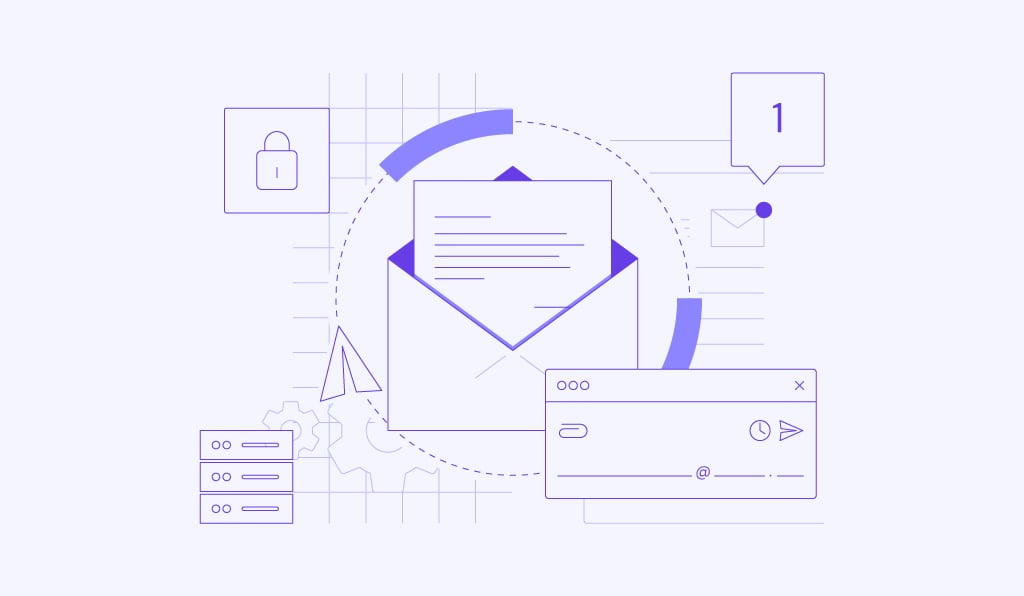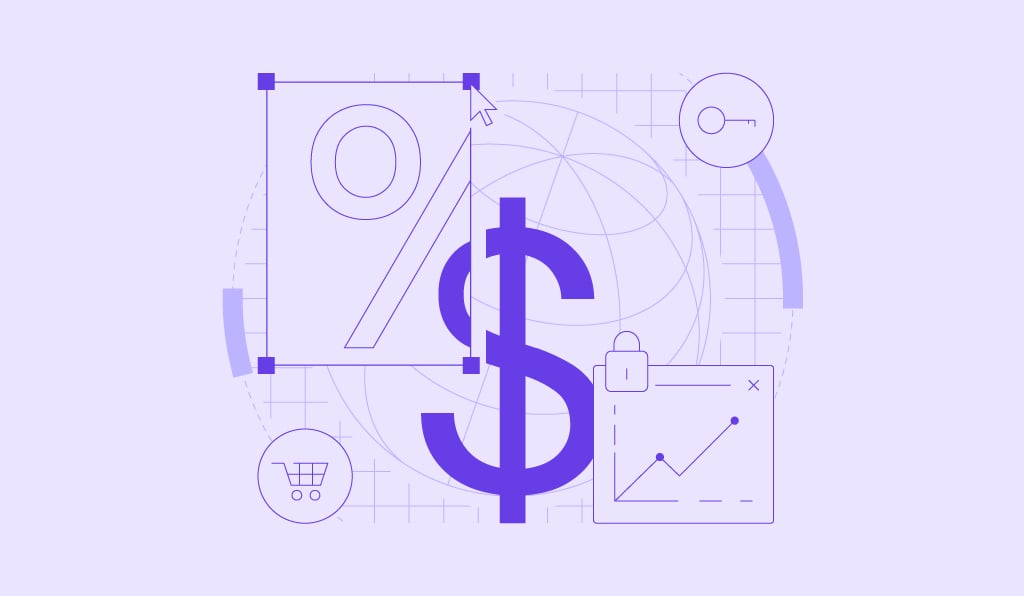Black Friday statistics 2025: Consumer insights and trends

Black Friday 2025 is projected to surpass $11 billion in US ecommerce sales, representing an 8.7% year-over-year increase. This growth signals increased transaction volume, heightened competition among retailers, and expanded discount opportunities for consumers.
Shopping trends reflect strong consumer engagement across digital channels. Globally, over half of shoppers make purchases online, while approximately 40% research products digitally before completing in-store transactions.
Black Friday and Cyber Monday have evolved from two separate 24-hour events into an extended shopping season. Data shows 45% of consumers began holiday purchases before November.
The following Black Friday statistics examine spending patterns, consumer behavior, device usage, demographic differences, and marketing performance during the Black Friday shopping period.
Hostinger’s 2024 study surveyed 1,000 US consumers about their Black Friday and Cyber Monday shopping preferences, spending habits, and product interests. Although collected in 2024, this data provides historical context that complements current industry trends in 2025.
Key Black Friday statistics for 2025
Black Friday has expanded beyond a single day into an extended period that sets the tone for the entire holiday season. These statistics illustrate the scale, consumer engagement, and economic impact of this shopping event.
- Holiday ecommerce sales are projected to grow 7%–9% year-over-year, reaching $305–$310.7 billion.
- The 2024 Thanksgiving weekend attracted 197 million shoppers, the second-highest total on record behind 2023.
- Black Friday and Cyber Monday combined are expected to exceed $25 billion in US online sales.
- Over half of online shoppers made purchases using mobile devices.
- Physical stores drew 81.7 million visitors, the highest number since the pandemic began.
- Average holiday spending reached $235 per shopper, an $8 increase from the previous year.
- Buy Now, Pay Later services processed nearly $1 billion in Cyber Monday purchases, representing a 5.5% increase from 2023.
- Despite concerns about inflation, 22% of shoppers plan to increase their holiday spending.
- Influencer and affiliate marketing converted shoppers at six times the rate of standard social media campaigns.
- Mobile devices accounted for 63% of Cyber Monday purchases, up from 55% in 2023.
Hostinger’s Black Friday study: Key insights
In 2024, Hostinger surveyed US consumers to understand their shopping behaviors during Black Friday. The study revealed key patterns in spending intentions, product preferences, and the influence of marketing channels.
While this data is from 2024, it provides valuable historical context that complements 2025 statistics.
- 82% of consumers planned to shop during Black Friday. High anticipation for deals confirms Black Friday’s status as a major retail event (Hostinger).
- 31% of US shoppers intended to increase their spending. US consumer optimism was higher compared to 2023 (Hostinger).
- Nearly 30% of respondents shopped exclusively online. Building accessible ecommerce platforms, such as those created with Hostinger Website Builder, helps businesses reach digital-first consumers effectively (Hostinger).
- 59% of US consumers reported that email marketing influenced their purchasing decisions. Email marketing achieves an 8% conversion rate and delivers $36–$50 ROI per dollar spent, outperforming most social channels (Hostinger).
- Gen Z and Millennials prioritized fashion and sustainable brands. Baby Boomers focused more on toys and gifts (Hostinger).

Our 2024 study highlights the sustained dominance of online shopping and the continued effectiveness of email marketing in driving Black Friday sales.
Black Friday spending and sales trends
Black Friday 2024 set new sales records, establishing strong momentum heading into 2025. Black Friday spending demonstrates consistent growth, with consumers showing sustained interest despite economic pressures.
- Black Friday 2024 online sales reached $10.8 billion in the US. This represents a 10.2% increase from 2023 and sets a new single-day record (Adobe).
- Black Friday 2025 online sales are projected to reach $11.7 billion. Cyber Monday is expected to be the season’s largest online shopping day, with sales projected to reach $14.2 billion (Adobe).
- Cyber Week 2024 generated $41.1 billion in online sales. The 8.2% year-over-year growth underscores the importance of the extended holiday period (Adobe).
- Only 22% of shoppers plan to spend more this season. This represents a decrease from the 31% who planned increased spending in Hostinger’s 2024 study. Current caution is attributed to 2.9% inflation in the US (Experian).
- Average holiday spending reached $235 per shopper. The $8 increase from the previous year indicates sustained consumer engagement, with 86% of consumers purchasing gifts (NRF).
- Holiday ecommerce sales are forecast at $305–$310.7 billion. The projected 7–9% growth indicates healthy expansion for online retail (Deloitte).
- The holiday season accounts for 24% of annual online shopping. This concentration makes it the most critical sales period for ecommerce businesses, according to our ecommerce statistics.
- Black Friday accounted for 33% of BFCM weekend sales. This outperformed Cyber Monday’s 23% share (Global-e).
- 197 million shoppers transacted between Thanksgiving and Cyber Monday. The 2024 weekend ranks as the second-highest participation on record, just behind 2023’s 200 million (NRF).
- 39% of shoppers follow a hybrid purchasing strategy. Most consumers browse online before completing in-store purchases (Experian).
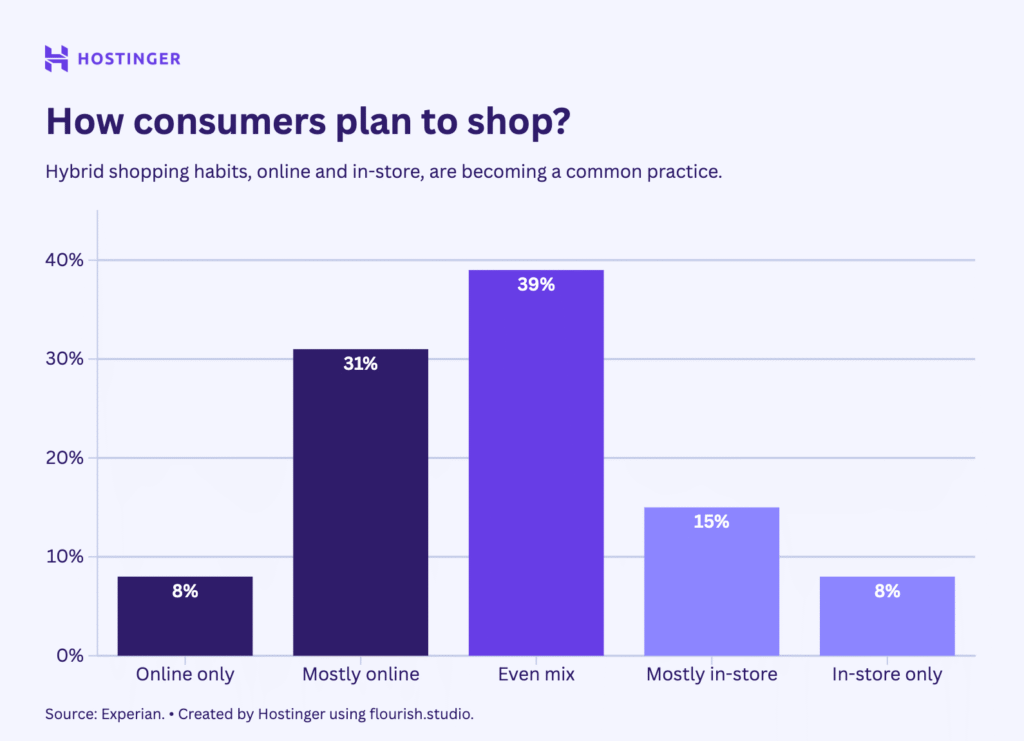
Black Friday remains a dominant force in retail sales. Consistent year-over-year growth in online spending demonstrates the need for strategic preparation, including competitive pricing, targeted marketing, and product innovation.
Black Friday consumer behavior and shopping preferences
Consumer shopping patterns reveal strategic behaviors that combine online research with in-store purchasing. While price remains the primary consideration, an omnichannel presence and early shopping windows are increasingly influencing consumer decisions.
- 42% of consumers engage in omnichannel shopping. Consumers blend online and in-store channels for research and purchases, requiring integrated retail strategies (NIQ). Hostinger’s 2024 study found that nearly 30% of respondents shopped exclusively online, a percentage expected to grow in 2025 (Hostinger).
- 45% of consumers start holiday shopping before November. The season extends into December, with 62% of customers continuing to make purchases throughout the month (Experian).
- Price is the deciding factor for 74.9% of consumers. Cost remains the most critical purchase consideration (NIQ).
- Department stores and online retailers tied as top destinations at 42% each. Grocery stores (40%) and clothing stores (37%) followed as popular channels (NRF).
- Online shopping attracted 87.3 million Black Friday shoppers. In-store shopping drew 81.7 million, the highest physical store count since the pandemic started (NRF).
- Saturday in-store shopping reached 61.1 million shoppers. Cyber Monday online shopping totaled 64.4 million, down from 73.1 million in 2023 (NRF).
- 52% of holiday shopping remained incomplete after the BFCM weekend. This indicates strong December sales potential (NRF).

Consumer demand for both online convenience and in-store experiences requires omnichannel strategies that extend beyond Black Friday and Cyber Monday. The early shopping trend creates multiple touchpoints for customer engagement throughout the season.
Black Friday mobile and device usage
Mobile devices have become the primary shopping tool for over half of online consumers. Smartphones dominate Black Friday browsing, price comparison, and purchasing activities.
- 63% of Cyber Monday shoppers completed purchases on mobile devices. This represents the highest mobile share on record and an 8 percentage point increase from 2023 (NRF). Hostinger’s 2024 study showed desktop and mobile usage nearly tied at 44%–46%, indicating rapid mobile growth (Hostinger).
- Mobile spending reached $69.8 billion, accounting for 53.1% of online sales. This 14.1% year-over-year increase confirms mobile as the dominant ecommerce channel (Adobe).
- 55% of global consumers shop on mobile devices. Gen Z leads this trend, with 68% preferring smartphones for shopping (BCG).
- 42% of consumers prefer retailer apps over websites. Apps provide enhanced shopping experiences (BCG).
- Gen Z mobile payment users are projected to reach 50 million by 2028. This growth reflects younger consumers’ preference for digital wallets (eMarketer).
- Responsive email design increases mobile clicks by 15%. With 64% of web traffic from mobile devices, mobile-first marketing is essential for engagement, according to our email marketing statistics.
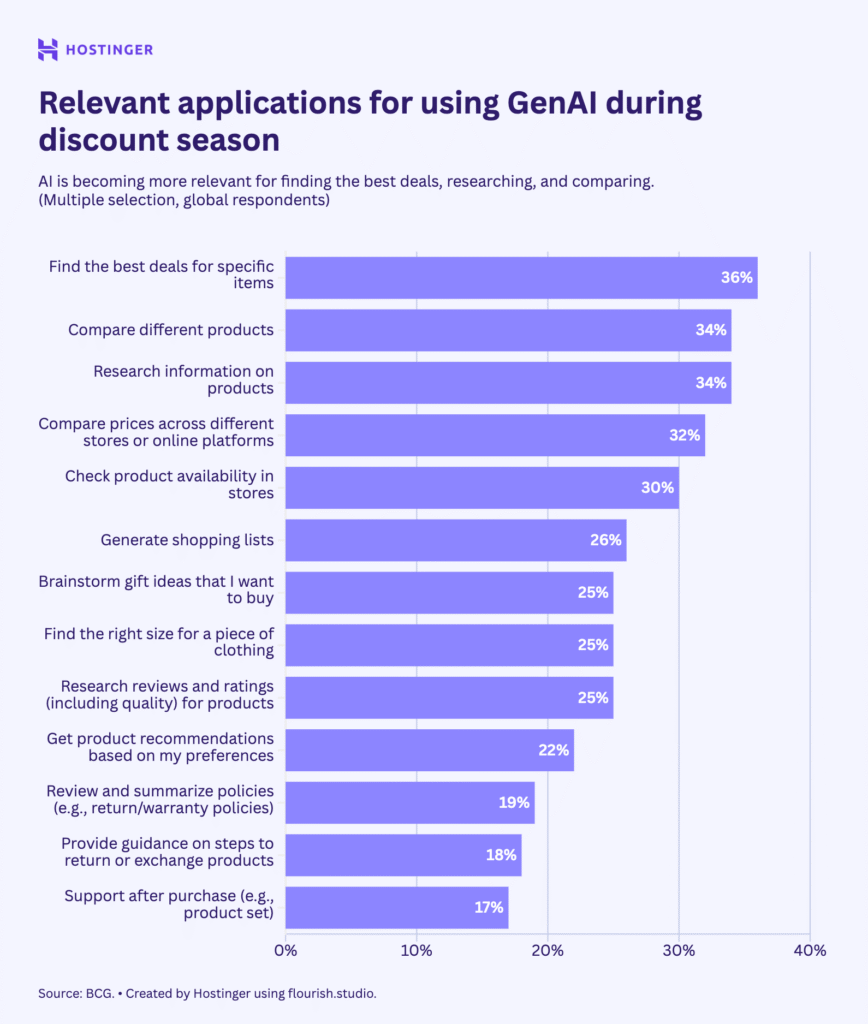
Mobile optimization is essential for Black Friday success. Businesses that prioritize responsive design and app experiences are better positioned to capitalize on the growing mobile sales market.
Black Friday demographics and generational differences
Each generation approaches Black Friday with different priorities and preferences. While Gen Z is drawn to social commerce and trendy brands, Millennials rely on established social networks.
- 75% of Gen Z consumers shop during Black Friday and Cyber Monday. Gen Z prioritizes fashion and sustainable brands, differentiating them from older generations (Statista). Hostinger’s 2024 study similarly found Gen Z and Millennials focused on fashion and sustainability, while Baby Boomers prioritized toys and gifts (Hostinger).
- 43% of Western consumers purchased from Temu in the past six months. Half of Gen Z consumers bought from Shein at least once, indicating Chinese retail apps play a significant role during BFCM (OBS).
- 73% of men view Black Friday deals as good value, compared to 67% of women. Women show more skepticism, with 23% suspecting inflated pre-discount pricing (OBS).
- Facebook is the preferred platform for 53% of Millennial shoppers. TikTok Shop leads among Gen Z, attracting 40% of users, according to Hostinger’s social commerce statistics (Hostinger).
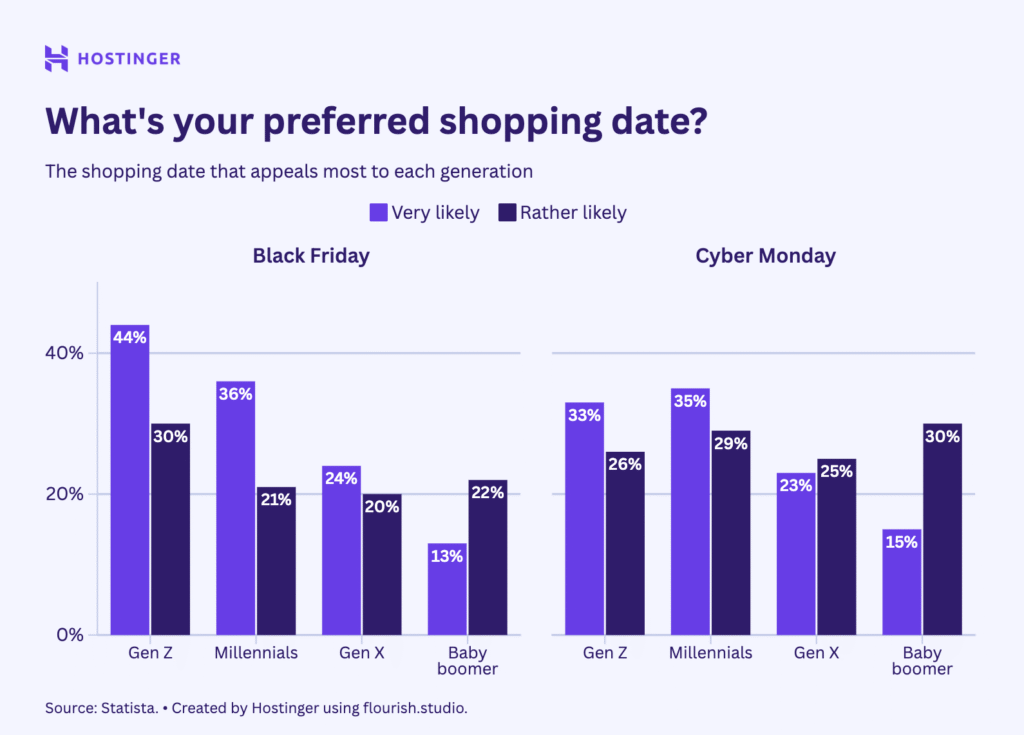
Different demographics require tailored approaches based on platform usage and product preferences. Retailers targeting Gen Z should prioritize TikTok Shop and emphasize sustainability in their branding, while those targeting Millennials should focus on maintaining a strong Facebook presence.
Black Friday marketing and conversion drivers
Consumer exposure to countless Black Friday offers makes understanding purchase motivators critical. Effective Black Friday marketing begins early and leverages multiple channels to build momentum.
- Free shipping, promotions, and positive reviews are top conversion drivers. These incentives effectively convert browsing into purchases (NRF). Impulse purchases accounted for 33% of transactions in Hostinger’s 2024 study, indicating that spontaneous spending remains a significant factor (Hostinger).
- 59% of US consumers reported email marketing influenced purchases. Email remains a direct, effective channel for driving sales (Hostinger).
- Buy Now, Pay Later services generated $991 million in Cyber Monday sales. This represents a 5.5% year-over-year increase, with 75% of BNPL orders placed on mobile devices (Adobe).
- AI-powered chatbots drove 1,950% year-over-year growth in retail traffic. While adoption remains modest, this surge signals growing consumer acceptance of AI shopping assistance (Adobe).
- 39% of consumers use AI for online shopping. A 5,000-response Adobe survey found that over half plan to use AI shopping tools in 2025 (Adobe).
- Affiliates and influencers drove 20.3% of Cyber Monday revenue. Influencers converted shoppers six times more effectively than standard social media marketing (Adobe).
- Early November promotions correlate with higher conversion rates. Discounts and urgency messaging before peak shopping days help build sustained sales momentum (Global-e).
Successful Black Friday marketing combines multiple channels with strategic incentives. Free shipping and positive reviews drive conversions, while early November promotions maintain momentum throughout the season.
The future of Black Friday
Black Friday continues evolving as a multi-week shopping period with increasing AI integration and diverse customer journeys.
- The shopping season continues to extend into October and December. Retailers compete for early shoppers by launching promotions earlier each year.
- AI-driven recommendations and dynamic pricing are becoming standard. Personalized product suggestions and real-time price adjustments create individualized shopping experiences.
- Mobile optimization is essential. Consumers are increasingly favoring smartphones over desktops, with brand interactions taking place across social media, websites, and mobile apps.
Supporting an extended shopping season and mobile-first customers requires a reliable and scalable infrastructure. Hostinger’s Black Friday web hosting deals provide the performance you need to handle increased holiday traffic.
All of the tutorial content on this website is subject to Hostinger's rigorous editorial standards and values.

